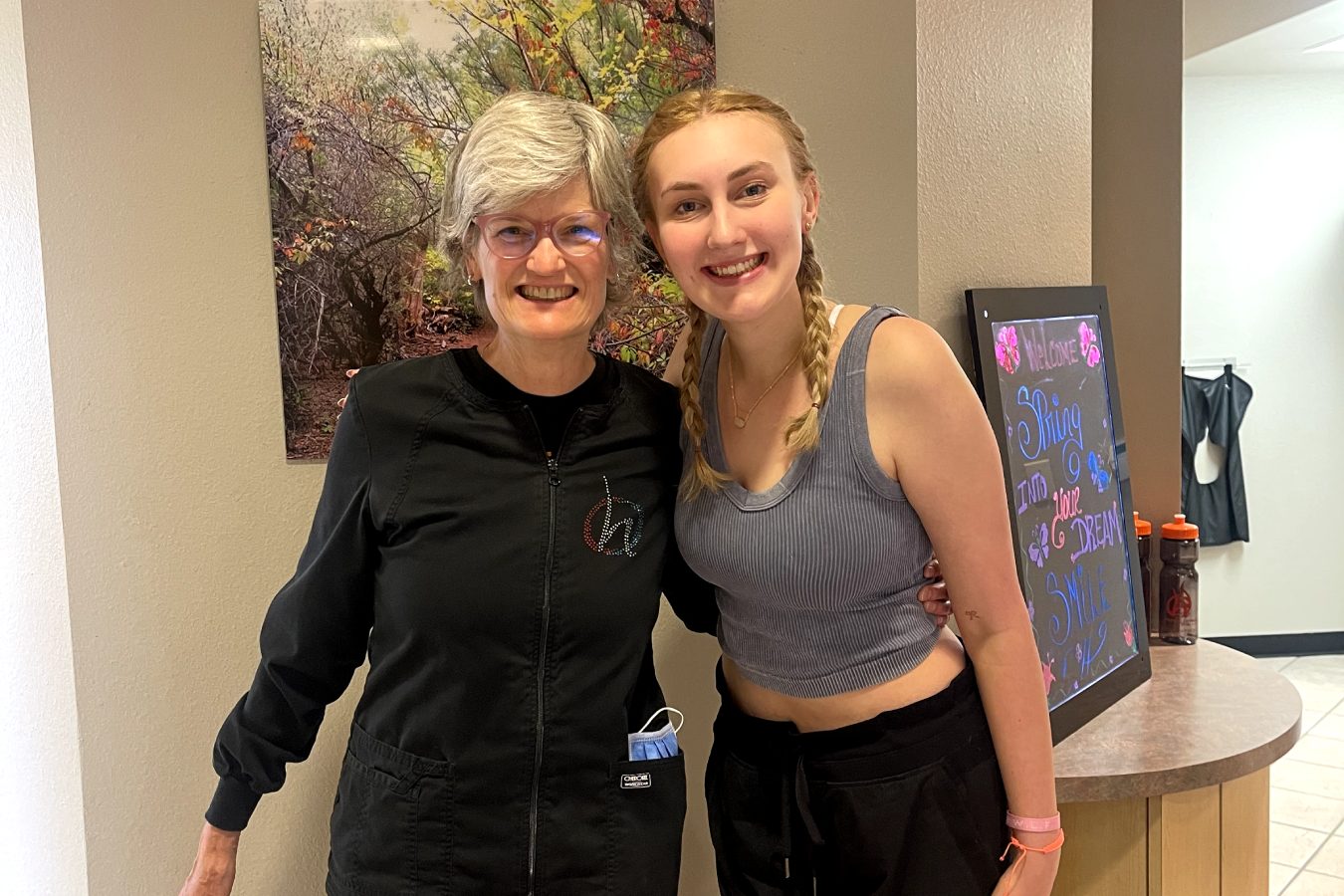Invisalign vs Braces
When it comes to straightening your teeth, both Invisalign and traditional braces are effective options, but each has its own set of advantages. At Haltom Orthodontics, we offer both treatments and will help you decide which is best suited to your needs and lifestyle.
Aesthetics & Comfort
Invisalign aligners are nearly invisible, making them an attractive option for those who prefer a discreet treatment. Made of smooth, clear plastic, they are custom-designed to fit comfortably over your teeth, minimizing irritation to the cheeks and gums. Because they are removable, you can take them out to eat, brush, and floss, allowing you to maintain your normal oral hygiene routine and enjoy your favorite foods without restrictions.
Traditional braces, made of metal or ceramic brackets and wires, are a highly effective solution for correcting more complex orthodontic issues. They are fixed to the teeth, which means you don’t have to worry about losing or misplacing them. While metal braces are more noticeable, ceramic braces offer a more subtle appearance with tooth-colored brackets. However, braces require special care when eating and cleaning to avoid damaging the brackets or wires.
Effectiveness & Treatment Time
Invisalign is highly effective for treating mild to moderate orthodontic issues, such as crowding, spacing, and minor bite problems. The aligners must be worn for 20 to 22 hours a day to achieve the best results. Treatment times can vary, but many patients complete their Invisalign treatment within 12 to 18 months.
Traditional braces are more versatile and can handle a wider range of orthodontic issues, including severe crowding, complex bite problems, and significant misalignments. Braces generally offer faster results for complex cases, and the treatment time can vary depending on the severity of the issue, typically ranging from 18 to 24 months.
Maintenance & Care
With Invisalign, maintenance is relatively simple. The aligners should be cleaned regularly with a toothbrush and lukewarm water. Because they are removable, you can easily maintain your oral hygiene routine by brushing and flossing as usual. However, it’s essential to keep track of your aligners and ensure they are worn consistently.
Braces require more attention when it comes to oral hygiene. Brushing and flossing around the brackets and wires can be challenging, and special tools, such as interdental brushes or floss threaders, may be needed. It’s also important to avoid certain foods that could damage the braces, such as sticky or hard items.
Cost & Insurance
The cost of both Invisalign and braces can vary depending on the complexity of your case and the length of orthodontic treatment. At Haltom Orthodontics, we offer flexible payment options and will work with your insurance to maximize your benefits, regardless of the treatment you choose.
Which Option is right for you?
Choosing between Invisalign and braces ultimately depends on your specific orthodontic needs, lifestyle preferences, and aesthetic considerations. Our board-certified orthodontists at Haltom Orthodontics are here to guide you through the decision-making process, ensuring that you receive the treatment that best suits your goals. Whether you opt for the discreet convenience of Invisalign or the robust reliability of traditional braces, you can trust that our team will help you achieve the smile you’ve always wanted.
If you’re ready to explore your orthodontic options, contact us today to request a consultation. We’re here to help you make an informed decision and start your journey toward a healthier, more beautiful smile.

TMJ Treatment
At Haltom Orthodontics, we specialize in treating Temporomandibular Joint Disorder (TMJ), a condition that can cause pain, discomfort, and difficulty with jaw movement. Our approach to TMJ treatment is comprehensive and personalized, focusing on non-surgical solutions that provide lasting relief.
TMJ disorder affects the joints connecting your jaw to your skull, leading to symptoms like jaw pain, headaches, earaches, and difficulty chewing. The condition can result from various factors, including teeth grinding (bruxism), jaw injuries, arthritis, or misaligned teeth. TMJ issues can also be exacerbated by stress, which may cause increased tension in the jaw muscles.
At Haltom Orthodontics, our board-certified orthodontists conduct a thorough evaluation to understand the root cause of your TMJ symptoms. This process may include a detailed review of your medical history, a physical examination of your jaw, and diagnostic imaging to assess the condition of your jaw joints and alignment.
Non-Surgical treatment options
We offer a range of non-surgical TMJ treatment options tailored to your needs:
- Custom-Fitted Night Guards — To alleviate the effects of teeth grinding, we provide custom-made night guards that protect your teeth and reduce jaw strain while you sleep.
- Bite Adjustment — If a misaligned bite is contributing to your TMJ symptoms, we may recommend orthodontic treatments like braces or Invisalign to correct your bite and relieve jaw pressure.
- Physical Therapy — We collaborate with physical therapists who can guide you through exercises designed to strengthen your jaw muscles, improve joint mobility, and reduce pain.
- Stress Management — Since stress can worsen TMJ symptoms, we offer guidance on stress reduction techniques, including relaxation exercises and lifestyle modifications, to help manage your condition.
Haltom Orthodontics has been family-owned and operated for over 54 years, with a strong reputation for excellence in orthodontic care. Our practice is known for its compassionate approach and commitment to delivering exceptional results, ensuring that each patient feels like part of the Haltom family. We are dedicated to providing personalized care and effective TMJ treatment to help you regain comfort and improve your quality of life.
If you’re struggling with TMJ symptoms, contact Haltom Orthodontics today to schedule a consultation. We’re here to help you find relief and restore your jaw’s function and comfort.

Bruxism Treatment
Bruxism, commonly known as teeth grinding or jaw clenching, is a condition where individuals grind or clench their teeth unconsciously, often during sleep. This habitual behavior can lead to a variety of dental and health issues, including tooth wear, jaw pain, headaches, and disrupted sleep.
Identifying bruxism can be challenging as it often occurs while you are asleep. However, some common symptoms include:
- Teeth Grinding Noises — A grinding sound may be audible to others or detectable on your own teeth.
- Jaw Pain — Discomfort or soreness in the jaw muscles, especially upon waking.
- Headaches — Frequent headaches, particularly around the temples.
- Worn Tooth Enamel — Noticeable wear or flattening of the teeth surfaces.
- Increased Tooth Sensitivity — Heightened sensitivity to hot or cold foods and beverages.
Bruxism can be triggered by various factors, including:
- Stress and Anxiety — Emotional stress is a common trigger for teeth grinding.
- Sleep Disorders — Conditions such as sleep apnea can contribute to bruxism.
- Misaligned Teeth — Dental misalignment or bite issues can cause grinding.
- Lifestyle Factors — Excessive caffeine or alcohol consumption may exacerbate the condition.
Effective treatment options
At Haltom Orthodontics, we offer a range of treatments tailored to address bruxism and its symptoms. Our approach focuses on both immediate relief and long-term solutions to prevent recurrence.
One of the most effective treatments for bruxism is the use of custom night guards. These oral appliances are designed to fit your teeth precisely, providing a cushioning effect that protects your teeth from grinding. Custom night guards are comfortable, durable, and made from high-quality materials to ensure optimal protection.
If misalignment or bite issues are contributing to your bruxism, orthodontic treatments may be necessary. Our team can evaluate your bite and recommend appropriate orthodontic solutions, such as braces or aligners, to correct any alignment issues and reduce grinding.
Since stress is a common trigger for bruxism, incorporating stress management techniques into your routine can be beneficial. We can provide recommendations on relaxation exercises, mindfulness practices, and other methods to help reduce stress levels.
Making certain lifestyle changes can also alleviate bruxism symptoms. Reducing caffeine and alcohol intake, avoiding chewing non-food items, and establishing a relaxing bedtime routine can help minimize grinding and clenching.
At Haltom Orthodontics, we are dedicated to providing personalized care and effective solutions for bruxism. Our experienced team takes the time to understand your unique needs and develop a treatment plan that addresses both the symptoms and underlying causes of your condition.
We use state-of-the-art orthodontic technology and advanced techniques to ensure you receive the best care possible. Our goal is to help you achieve relief from bruxism and restore your oral health and comfort.
If you suspect you may be suffering from bruxism or if you experience symptoms of teeth grinding, don’t wait to seek help. Contact Haltom Orthodontics today to schedule a consultation. Our knowledgeable team is here to answer your questions, provide a thorough evaluation, and recommend the most effective treatment options for your situation.

Emergency Care
In orthodontics, emergencies can arise unexpectedly and require prompt attention. At Haltom Orthodontics, we are committed to ensuring that you receive the care you need when you need it most. Whether you experience an issue with your braces or another orthodontic appliance, our team is here to provide expert assistance and support.
common orthodontic issues
Understanding the types of emergencies that can occur with orthodontic treatment helps you know when to seek immediate care. Common orthodontic emergencies include:
- Broken Brackets or Wires — A bracket may come loose, or a wire may break, causing discomfort or affecting your treatment progress.
- Loose or Missing Appliances — If a component of your orthodontic appliance becomes loose or falls out, it’s important to address it promptly.
- Poking Wires — Wires that shift or become dislodged can poke and irritate the inside of your mouth, causing pain.
- Severe Discomfort or Pain — Any significant or sudden pain in your teeth, gums, or jaw that does not improve with over-the-counter pain relief should be evaluated.
What to do in an emergency
If you encounter an orthodontic emergency, follow these steps to manage the situation until you can receive professional care:
- Call our office as soon as you notice an issue. We will provide guidance on how to manage the situation and schedule an emergency appointment if necessary.
- Use orthodontic wax to cover any poking wires or sharp edges. Over-the-counter pain relievers can help alleviate discomfort, but avoid placing medication directly on the affected area.
- Maintain good oral hygiene by gently brushing and flossing around the affected area to prevent any additional problems.
- If possible, save any broken pieces or components of your appliance and bring them to your appointment.
While emergencies can occur, there are steps you can take to minimize the likelihood of problems:
- Follow Care Instructions — Adhere to the care and maintenance guidelines provided by our team.
- Avoid Hard or Sticky Foods — These can damage your braces or orthodontic appliances.
- Attend Regular Check-Ups — Routine visits allow us to monitor your progress and address any potential issues before they become emergencies.
If you experience an orthodontic emergency, do not hesitate to reach out to Haltom Orthodontics. Our team is here to provide prompt and effective care to ensure your treatment continues smoothly. Call us today to schedule an emergency appointment or for guidance on managing your situation.